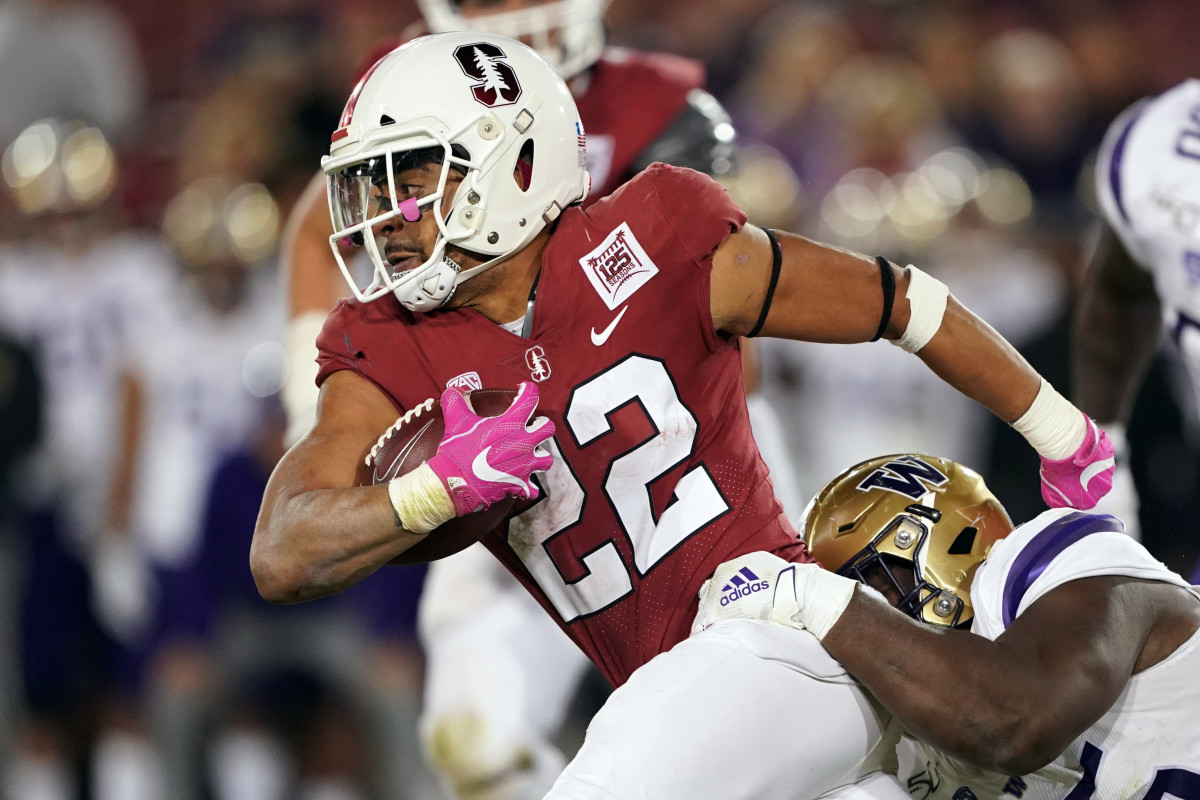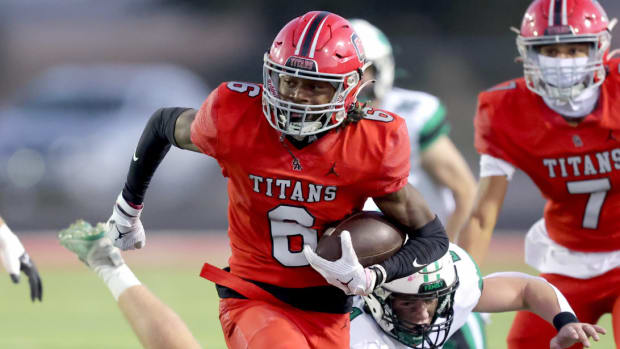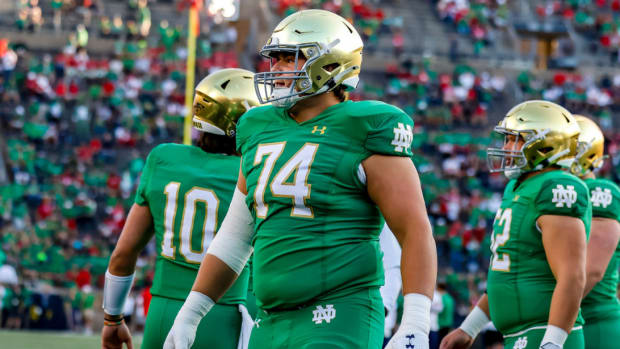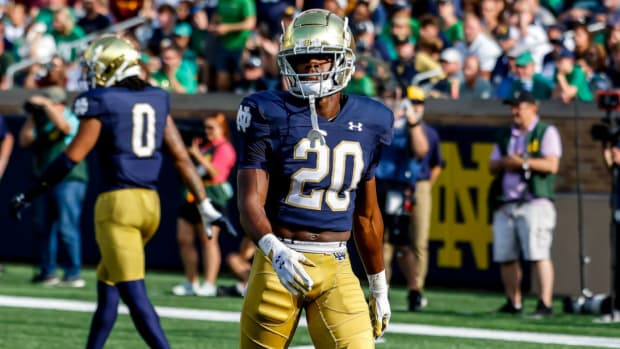Stacking Up: Notre Dame Defense vs. Stanford

No. 16 Notre Dame (9-2) heads out West this weekend in hopes of earning its tenth win of the season, and first victory inside Stanford Stadium since 2007.
The good news for the Fighting Irish is it will be taking arguably its best defense since 1993 into Stanford Stadium. Keep in mind the Irish did not travel to Stanford in 2018, 2012 or 2002.
Notre Dame has a significant matchup advantage on paper, which should give Irish fans a great deal of confidence heading into this matchup.
NOTRE DAME SCORING DEFENSE vs. STANFORD SCORING OFFENSE
Advantage: Notre Dame
From 2009 to 2017 — a span of five games — Notre Dame allowed 35.2 points per game in road games against Stanford. None of those defenses, however, were nearly as good as the unit Clark Lea will put on the field Saturday afternoon.
Lea’s group ranks 16th nationally in scoring defense, 17th in total defense and 13th in yards allowed per play.
Notre Dame gave up 426 yards and 437 yards in back-to-back games against USC and Michigan, but none of the other nine opponents reached the 400-yard plateau. Since its loss at Michigan the defense has been especially dominant. Notre Dame has given up just 11.8 defensive points and 245.8 yards in its last four games while holding opponents to just 3.7 yards per play.
Here's a stat to put the recent defensive dominance in perspective. From 2010 to 2018, the first nine years of Brian Kelly's tenure at Notre Dame, the Irish defense held just three opponents to under 200 yards of offense: Army in 2010, Texas in 2015 and NC State in 2016.
The 2019 defense has done that twice in its last three games, holding both Duke (197) and Boston College (191) to under 200 yards.
A key to Notre Dame’s defensive turnaround has been its ability to get off the field at a greater rate. Last fall, Notre Dame ranked 45th in turnovers gained and 65th in third-down defense. The Irish had to rely on the nation’s 11th best red zone defense to get stops.
This season, Notre Dame has the second worst red zone defense in the country, but it’s still giving up the same number of points as it did a season ago because the defense ranks third in turnovers gained and 20th in third-down defense.
One concern for the defense in this matchup is health. Notre Dame is already without ends Julian Okwara and Daelin Hayes, and linebackers Jack Lamb and Shayne Simon, but defensive tackles Myron Tagovailoa-Amosa and Jayson Ademilola are also hobbled with ankle injuries, and their status is uncertain.
The last five times Notre Dame traveled to Stanford Stadium it faced a Cardinal offense that averaged between 32.3 and 43.2 points per game. The offense it will face on Saturday isn’t anywhere close to that level. Injuries along the offensive line and at quarterback have ravaged the Stanford offense, which is a shell of its former self.
Stanford has been held to 23 points or less in eight games this season, and it topped 30 points in just two contests. Stanford has gone over 400 yards just three times, although its season high came just two games ago in a 49-22 loss to Washington State.
A missed field goal, a red zone interception and another turnover near midfield ruined a night in which the Cardinal offense churned out 501 yards and averaged a season-best 8.5 yards per play.
NOTRE DAME RUSH DEFENSE vs. STANFORD RUSH OFFENSE
Advantage: Notre Dame
Notre Dame ranks 75th in the country in rushing defense, giving up an average of 164.5 yards per game. While the defense was inconsistent on the ground for much of the first seven games, its current average is a bit misleading.
Notre Dame has played a pair of Top 10 rushing offenses and five offenses that rank in the Top 35 in rushing yards per game.
Notre Dame started the season against Louisville and New Mexico, a pair of offenses that rank in the Top 35. Notre Dame allowed both to go above their season average. Since then, against Georgia, Navy and Boston College the Irish held each below their season average. In fact, Notre Dame held those three offenses to an average of 85.7 yards below their current rushing average.
Since giving up 303 yards in a loss to Michigan, the Irish run defense has played its best football of the season. Notre Dame held Virginia Tech to just 96 yards on the ground and Duke gained just 95 yards. Navy racked up 281 yards, but that was 77 yards below their season average coming into the contest. Notre Dame held Boston College 154 yards below its average coming into that game.
Improvement at linebacker has been a key to Notre Dame’s recent success against the run, but Lea has also continued to adapt to the strengths of his players.
From 2009 to 2017, Stanford averaged at least 202.4 rushing yards per game in all but one season. During that stretch it had a running back rush for at least 1,330 yards seven different times. If the entire Stanford offense wants to get to that mark in 2019 it will need to rush for 182 yards against Notre Dame, a total it topped just once all season.
Former running back Bryce Love rushed for 2,118 yards in 2017, but in the last two seasons the Cardinal have averaged just 106.3 yards per game. It is truly mind boggling to see how hard and how fast the Stanford run game has fallen.
Senior running back Cameron Scarlett is a solid player (797 yards, 4.2 YPC) and freshman Austin Jones (194 yards, 5.1 YPC) has a bright future, but the play of the offensive line has been absolutely abysmal.
Stanford has been held to 100 yards or less five times, and less than 125 yards in seven games. Only once has Stanford rushed for more than 150 yards, and only three times has it topped 5.0 yards per carry. It has rushed for just 67 combined yards in the last two games.
Running the ball is still key to Stanford being successful. In its four wins the Cardinal have averaged 142.8 yards and 4.0 yards per carry. In its seven losses Stanford has averaged just 82.4 yards and 3.3 yards per carry.
NOTRE DAME PASS DEFENSE vs. STANFORD PASS OFFENSE
Advantage: Notre Dame
Notre Dame’s pass defense has been outstanding for much of the season. Its raw numbers are certainly impressive. Notre Dame ranks third in the country in fewest passing yards allowed, fifth in yards allowed per attempt, fifth in pass efficiency defense, 14th in yards allowed per completion and 14th in fewest touchdowns allowed.
But dive deeper into the numbers and that production stands out even more. Virginia is the only offense to surpass its season average in passing yards against Notre Dame.
In fact, Notre Dame has held each of its ten other opponents to at least 24 yards below their season average, and all but two of those teams (Georgia, Navy) have gone at least 52 yards below their season average. The Irish held Louisville, Michigan and Boston College to at least 104 yards below their season average.
Not a single defensive back has played to the level we saw from Julian Love last season, or even how well Troy Pride Jr. played in the final six games. The pass rush also isn’t as good, but the overall team defense has been outstanding. The pass rush has been good, the secondary coverage has been good and the coverage at linebacker has taken a huge step forward in my view.
Stanford has put up a lot of passing yards, but a big part of that has been the fact the Cardinal have trailed so much. While Stanford ranks 39th nationally in passing yards, it ranks just 76th in passing touchdowns, 77th in yards per attempt, 77th in pass efficiency, 94th in sacks allowed and 97th in yards per completion.
The Cardinal have started three different quarterbacks due to injury. KJ Costello started the season but played just five games due to multiple injuries. He was replaced by Davis Mills, who also missed time with an injury.
Mills is back to good health and will start against Notre Dame. The former five-star recruit has been quite productive in his last four starts, completing 70-percent of his passes while averaging 333.0 yards per game. He passed for 504 yards against Washington State, but threw for at least 290 yards in the start before and after that contest.
Mills has thrown four picks in his last two games, which is a byproduct of the poor run game putting so much emphasis on slowing down the pass game.Although the season has been a huge disappointment, the pass catchers have been a bright spot. Stanford has five players with at least 500 yards receiving. The unit is led by standout tight end , who has 45 catches and 552 yards on the season.
Although the season has been a huge disappointment, the pass catchers have been a bright spot. Stanford has five players with at least 500 yards receiving. The unit is led by standout tight end Colby Parkinson, who has 45 catches and 552 yards on the season.
Follow me on Twitter: @CoachD178
Visit our Facebook page at: https://www.facebook.com/IrishMaven/








